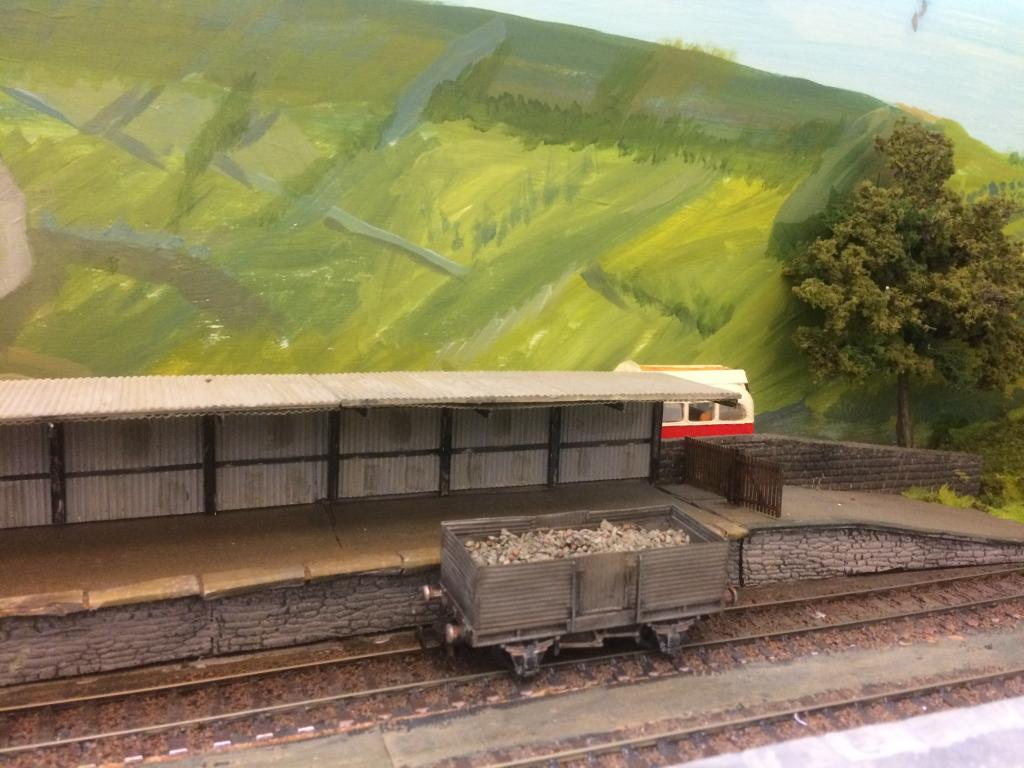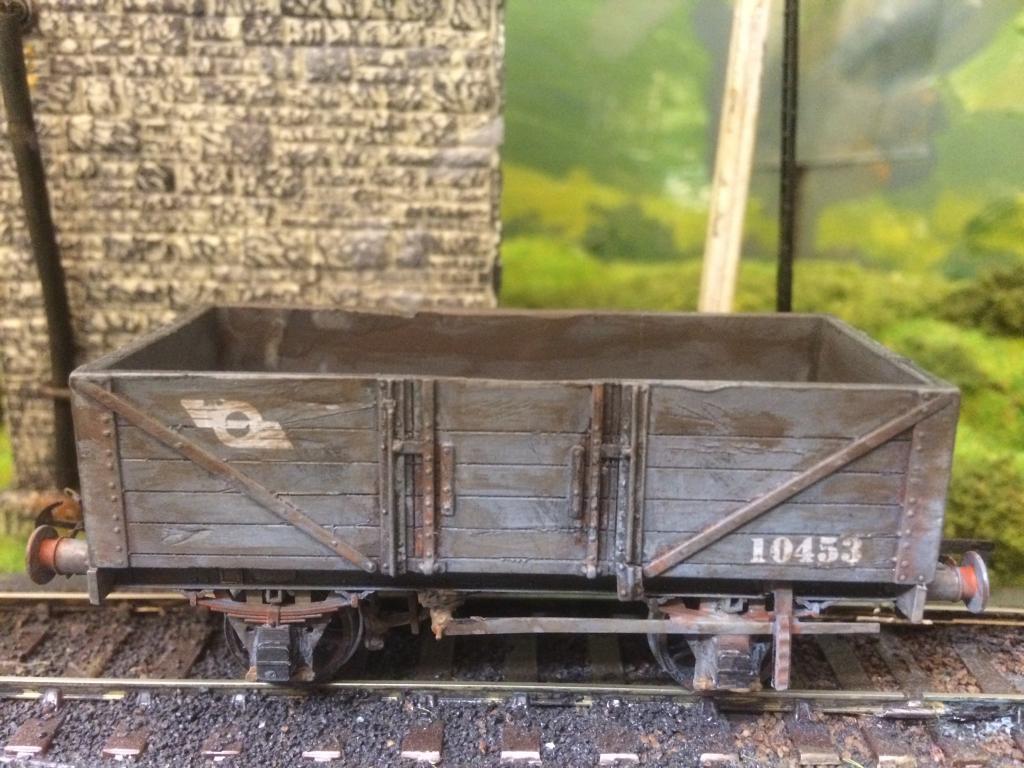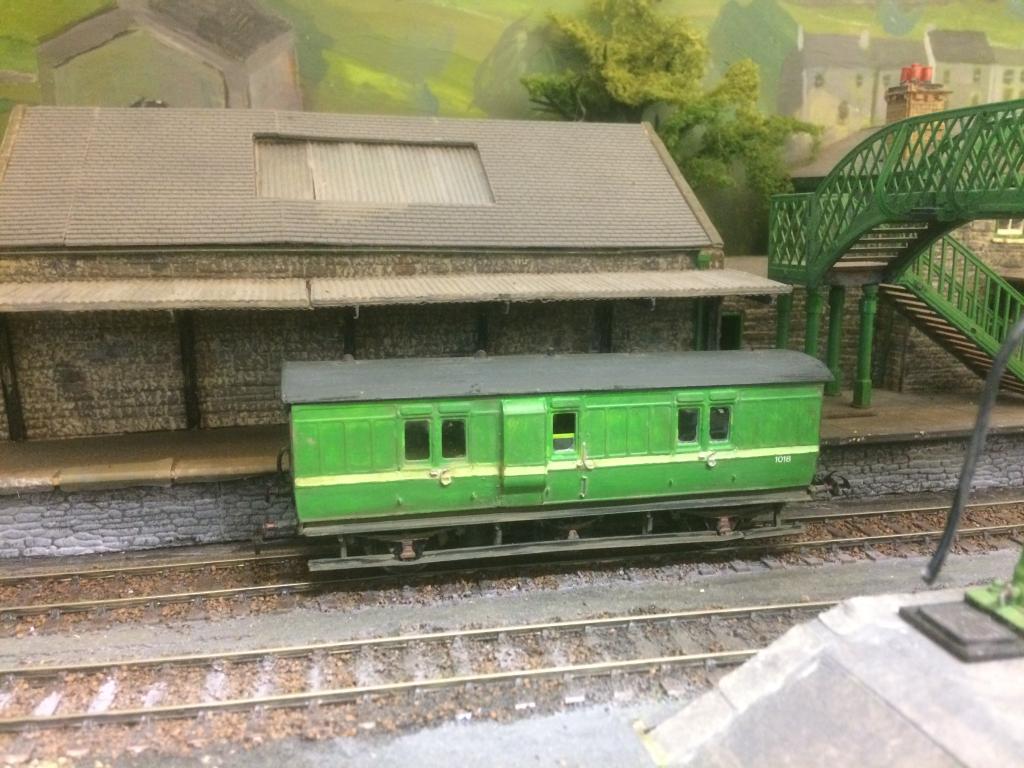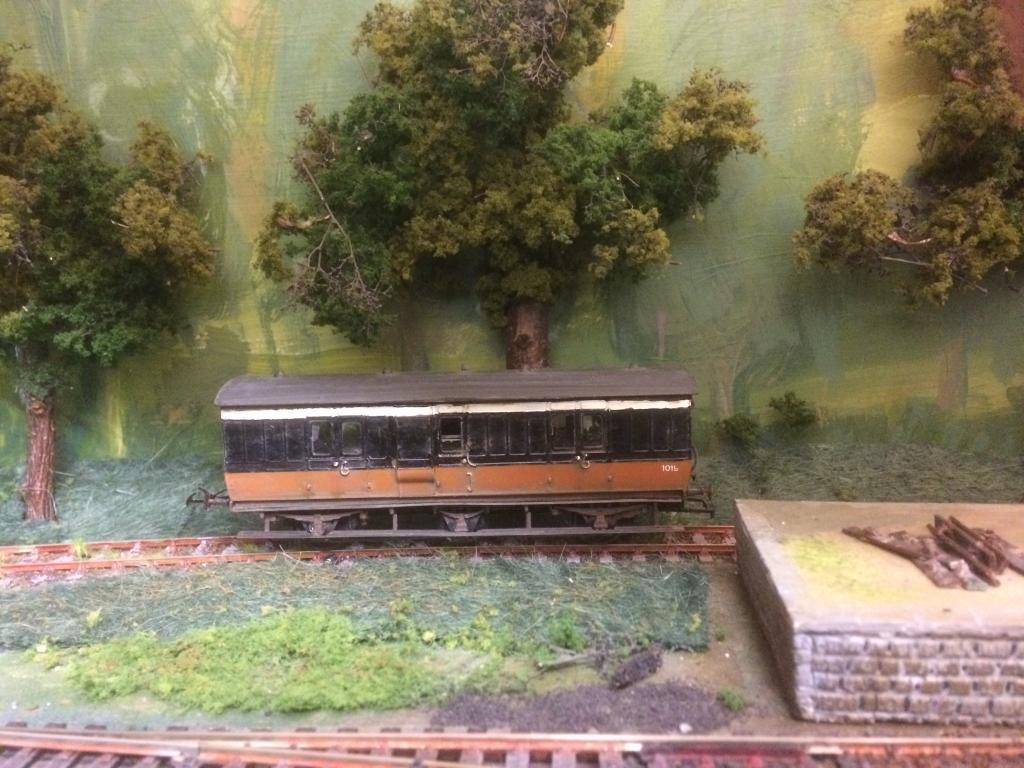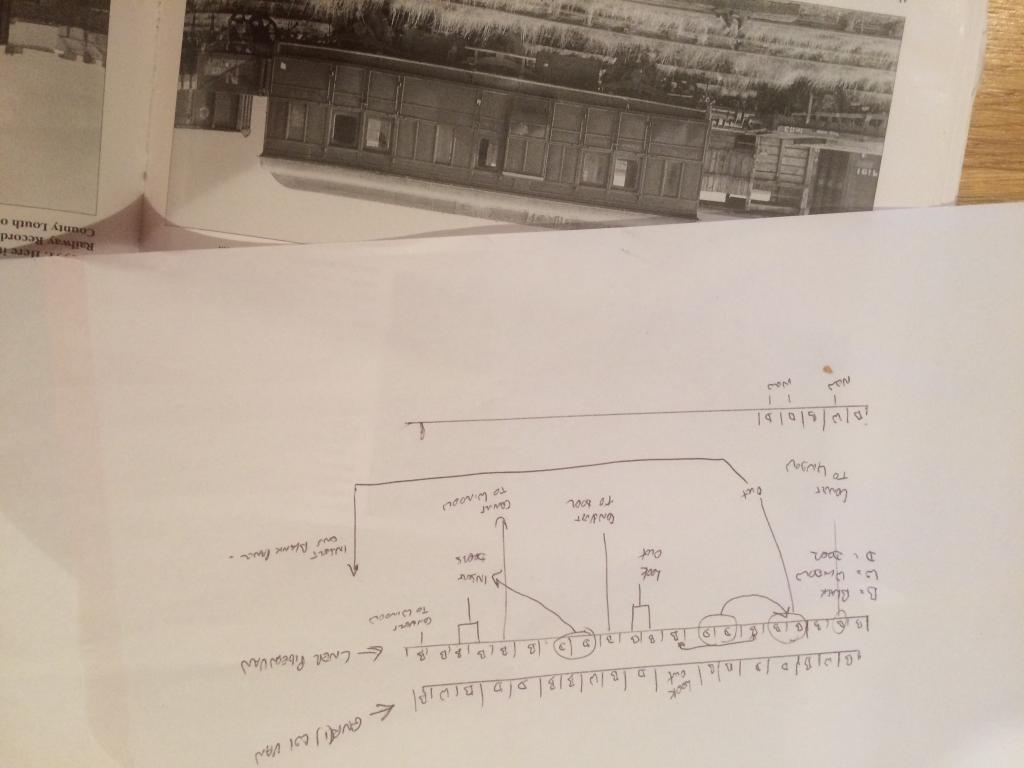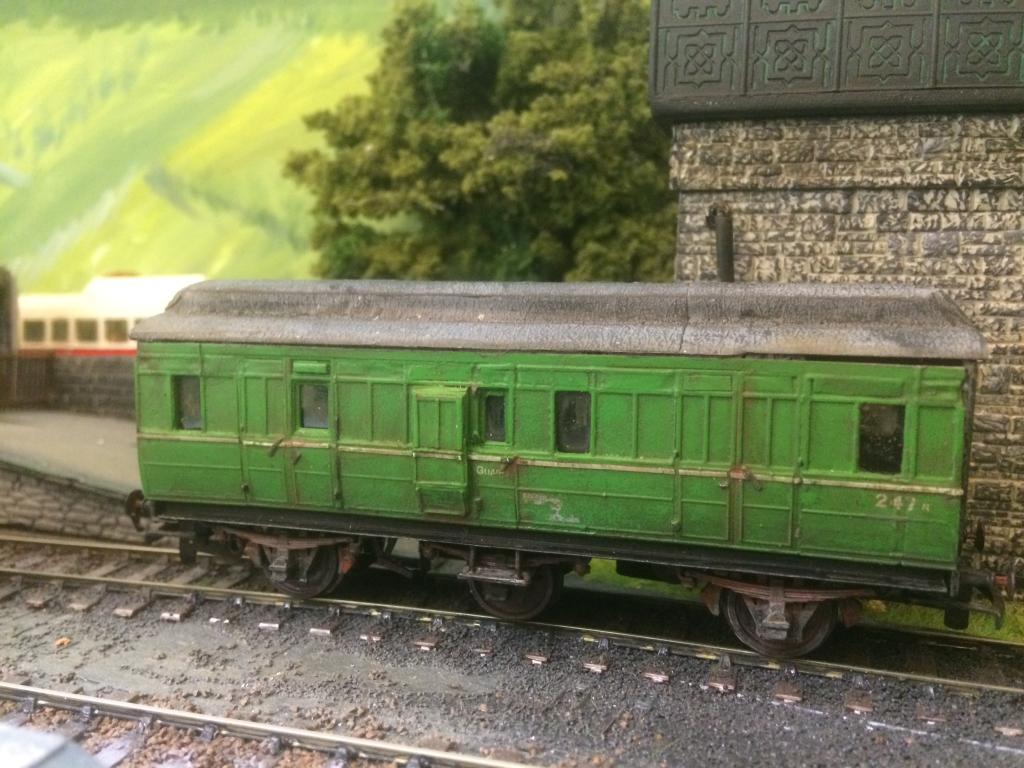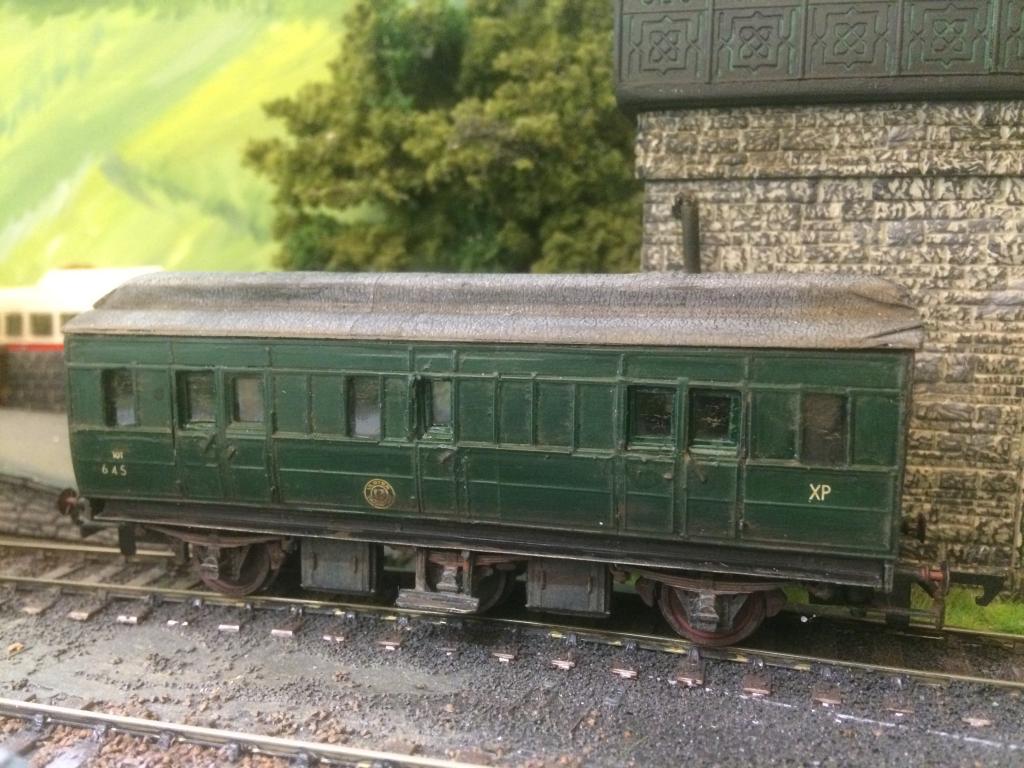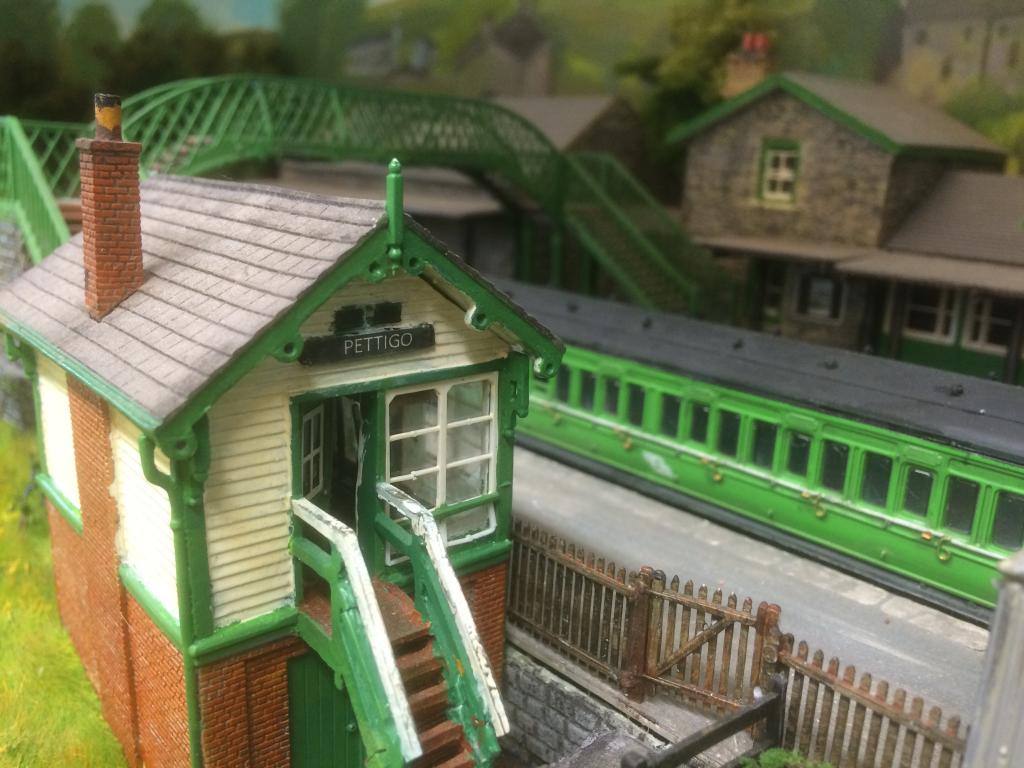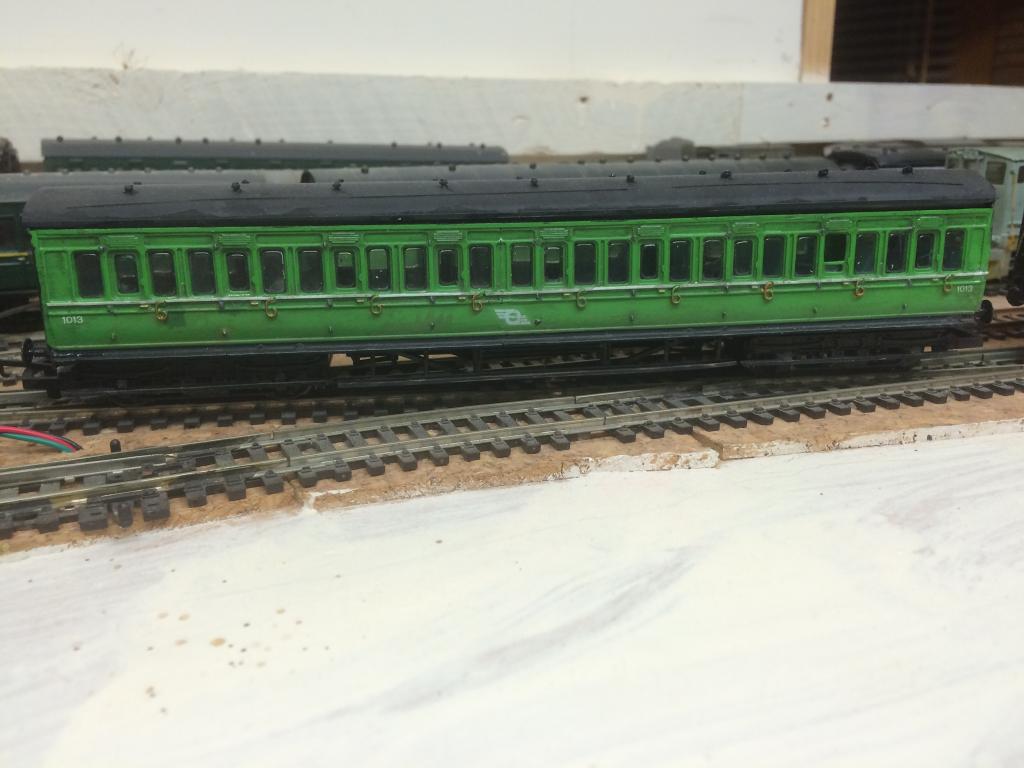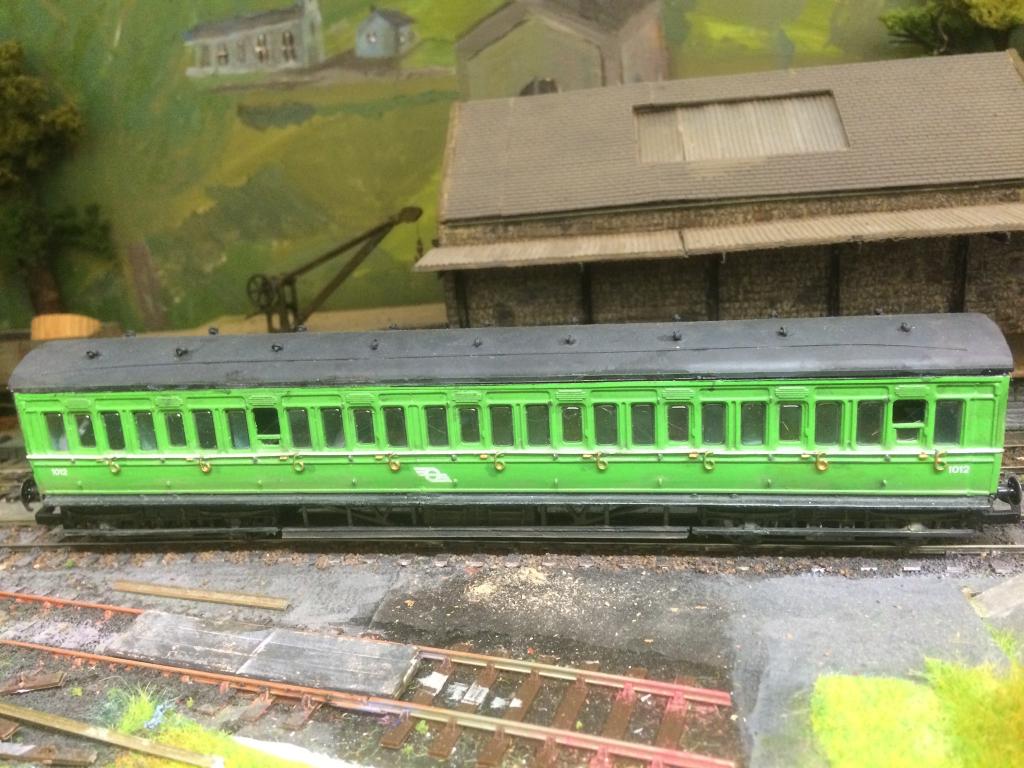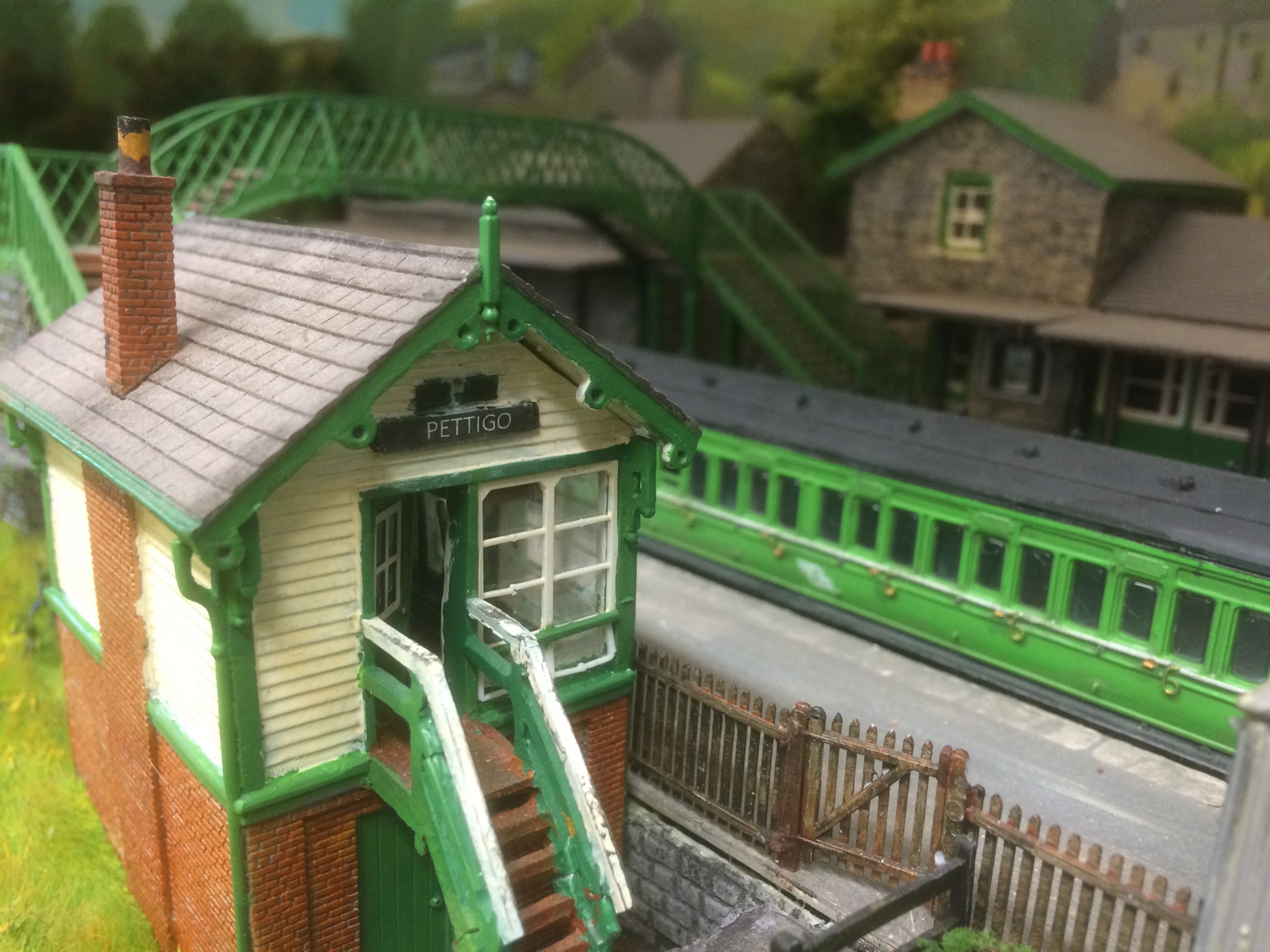
Glover
Members-
Posts
144 -
Joined
-
Last visited
-
Days Won
6
Content Type
Profiles
Forums
Events
Gallery
Everything posted by Glover
-
I mentioned that the wooden bodied open wagon, as bought, was mounted on the (very) old Hornby Dublo cast solid chassis; it didn't go to waste, although some might feel it should have. For a number of years, I've been building up a ballast train, inspired by a photo of such a train at Bundoran Junction. The train is a mixture of wooden bodied wagons, including one with faded GN lettering and a representation of the Bullied corrugated open. I should say that I started making these before the Provincial Wagons versions were even thought off. The bodies are knocked up from corrugated plastic; possibly Slaters - I bought the plastic years ago. I retained the old HD couplings ; Peco still sell the equivalent as Simplex. Some of the wagons in the train are on chassis' that I had as a kid. They must be at least 50 years old. The whole exercise is a mixture of making-do/never throwing anything away and nostalgia.
-
Many thanks John, what a superb photo! I have to say I'm rather pleased with this little wagon. That Hornby Dublo moulding is as good as anything around today. It must be 50 plus years old. JHB: thanks for the info. I may have a second go at that GWSR Luggage Brake van; wider, a bit taller and flat ends. Cheers, Glover
-
I'll do some notes and photos of my layout, in a few weeks time; bit busy with some other issues at the moment! In the meantime, some wagons. I don't know what the actual numbers were but Irish goods trains seemed to be made up pro dominantly from covered vans. However, we can justify some. This is the old Hornby Dublo 5 plank open. I bought it at one of the toy fairs last year for about €2 or €3. It was mounted on the old solid cast under frames ( although that didn't go to waste.....). I used a Parkside Dundas under frame kit with buffers from MJT; Irish wagons, especially from Inchicore often seemed to use relatively large buffers. The very basic brake gear is mostly from a Studio Scales Models etch which I bought some years ago. Decals are also from SSM. Before painting, I subjected the wagon to some " bruising and battering". Basically, just scratch at it and hit it with various implements; very hi tech stuff!
-
Thanks JHB for the info re UTA lining. This 30 foot 6 wheel guards/luggage van appears in the many photos taken during the week long grand steam tour of Ireland in June 1964. It was I suspect built in the early 1900s, by the GSWR. It's a relatively straightforward job, involving the use of the guards section of two Ratio GWR 4 wheel coaches. I added a middle axel guard, cut from the Ratio under frame. The wheel is dummy; the flange filed off a plastic wheel. In the 1964 photos, it's painted in the then new Black and Tan livery but given that my layout is set in 1963, I think it reasonable to paint one side in CIE green. If I were doing it again, I would figure out a way to widen it, from the current 8 foot to something closer to 9 foot, thus replicating the wider appearance of Irish stock.
-
A very impressive body of work. And virtually no just "opening the box"! You are, in a way, following in the footsteps of Cyril Fry, who built up a representative collection of models representing Irish railways from the earliest years to the early '60s. Cheers Glover
-
Thank you Dhu Varren for that info. Coakham says one of the vans ended up in the Portadown breakdown train; do you happen to know which one? My layout is a continuous run but all sides against walls; I have to (remember to!) duck under, therefore only one side is ever visible. In fact, quite a few of my wagons are really only fully finished on one side. Apart from the fact that the vans never made it into ordinary UTA service, I'm still a bit unhappy with the lettering etc on that side. Am I right in saying that UTA numbering etc was in yellow? I followed, in general terms, the lettering on Y2 class 4 wheel van shown on page 63 of Coakhams' book. For those who might (in a moment of madness) be tempted to try this conversion, I should add three points which I forgot to mention earlier. 1. I made the CIE side first and didn't cut out the full range of windows. The UTA side (the better one!) has the full set. 2. In order to add some height to the van, I added a strip of Evergreen plastic along the top. On the Uta side, I actually off the top, including the small,narrow windows and then added the plastic. A better job I think. 3. I used the end from the pigeon van kit but reprofiled it to match the Hornby roof. Many thanks, Glover
-
Sorry about the duplication of photos; I'm still trying to figure things out ( in general.....) Glover
-
Many thanks to you all. In the early 1900s, the GNR built new trains to run between Dublin and Belfast. Three of these 6 wheel clerestory guards/luggage vans were built, designated W1. There is a clear side on view of 247 in Desmond Coakhams' book, Irish Broad Gauge Carriages. The sides are modified from the Chivers Finecast LNER pigeon van. It requires a lot of cutting and shutting; I found it best to write out the door/window/panel layout for both the pigeon van as bought and the W1. Reducing the pigeon van by approx one panel reduces the overall length to 30 feet. You can figure out your own solution as to why one side ends up shorter (or longer...) than the other! The roof is left over from the Triang Hornby GWR conversion ( first post), covered with sticky address labels to replicate what appears to be a recovering job in the photo. The under frame is from the Ratio 4 wheel GWR coach kit, with an extra set of axel guards added; the middle wheel is a dummy. The van was photographed in 1959 but I've assumed it lasted to mid 1963. In that case, it's a toss of the coin as to whether it ended up with CIE or the UTA. I've taken that as an opportunity to paint it light CIE green one side ( with a small "n" added after the number)and dark UTA green on the other. Yes, the UTA creast should be higher and, I see from the latest New Irish Lines, that I have chosen a number allocated to a different ex GNR van. I'll live with it! Note that there is a guards look out on one side only. Coakham says one was removed at some stage.
-
Thanks JHB. My model actually assumes that the Bundoran branch stayed open, at least to 1963, under CIE control. This was legally possible as the ROI or NI governments could take over what I think were termed "shared services" ie routes which crossed the border. There was the usual fuss in the Dail at the time, with the Government of the day being urged to retain the service. So, it could have happened but in reality, not a hope! Cheers, Glover
-
JHB, I think I can provide some information in respect of the 121s in the original grey livery. In the June 1999 issue of the IRRS Journal(issue 139), there is a "full frontal" colour photo of B125 taken at Mullingar in 1963. There is a clear dark, call it black, surround to the flying snail and the number. Red buffer beams: the February 1971 issue of Irish Railfans News (now archived I think on the RPSI web site) contains a survey of the liveries carried by the various members of the B class. The article notes that originally the 121s were grey with yellow lettering and the yellow band along the frame. However, B123 and B127 received red buffer beams in 1961 and 1962 respectively. This was carried out by Grand Canal Street depot when the locos were rostered to haul the high profile Wexford Opera Specials. There is/was a photo on the wall in Marks Models, Hawkins St showing one of these locos; the only colour photo I've ever seen of them. I passed this information on to Murphy Models, via Marks, so I suppose it is possible that we may one day see this variation on a RTR "Yank". Cheers, Glover
-
Sorry, Pettigo- so good they named it three times! Glover
-
Beautiful! Many thanks. I'm actually modelling Pettigo, on the Bundoran branch, so photos from this area are always welcome. I've started my own workbench thread on this forum, only about an hour ago. Here is a photo of the signal box, using the Bachmann Scenecraft box that I mentioned earlier. I did modify the windows but of course I can't see them now! Cheers, Glover
-
That seemed to work! The extract from the Railway Modeller was the first in a series which achieved near legendary status. The first article appeared in August 1966. It dealt with the conversion of the Triang Hornby GWR clear storey coach into Southern Railway ( England) look alikes. Given the similarity to Irish coaches, I resolved to follow the plans. Only took me 50 years! However, I went a little further; about 6 feet...... The original plan was for LBSCR 54 foot coaches but the similar GWSR/GSR coaches were 60 footers. Essentially you cut the passenger sections from two GWR brake 3rds and join them together. However, I decided to widen them somewhat, to replicate the wider dimensions of Irish stock. That involved some rather agricultural cutting of the sides away from the original chassis. I also added some height to the coach using Evergreen strip. I scratch built new ends although the roof is BR Mk1. Bogies are Bachmann LMS.
-
Can I just post this photo and a few lines, just to make sure I'm doing things right: haven't started a thread on this forum before. Cheers, Glover
-
Bachmann, in their Scenecraft range, did a number of Irish railway structures a few years ago, one of which was a GNR signal box. To be totally accurate, the windows needed modification. I'm sorry that I didn't buy two at the time as I suspect the production run was quite short. I think I'm right in saying that they were only sold through Irish retailers. Love your photos from Omagh; keep them coming. Regards, Glover
-
Thanks jhb. I envisage the Bundoran Express operating much as it did in GNR days, with a UTA coach from Belfast being attached at Clones. Liveries would be a mix of CIE green, black & tan plus UTA green. Coaching stock would as you say be a mixture of various CIE/GSR types but also with a healthy mixture of former GNR stock, especially those very distinctive K15 types; I have one built so far. I am assuming that the goods trains were operated by CIE, serving the stations in the Republic; Pettigo, Ballyshannon and Bundoran. I had planned that the branch service would also be CIE operated but am coming round to the view that UTA operation would be more plausible. That could be diesel or steam, hence my interest in the 00Works U class loco. Coaching in this case would be ex GNR. I also have a vision that the Sligo Leitrim Railcar B might appear but I haven't yet come up with an answer to the question "why?". To Weshtys earlier comment about doing a brass etch for the U class, such a possibility might push me over the line! Cheers, Glover
-
This announcement has thrown me! I am modelling the Bundoran branch (well, Pettigo anyway) but set in 1963. Under the legislation which set up the Great Northern Railway Board, either the Dublin or Storment governments of the day could have continued working a "joint service" I.e. A cross border line on their own.I've assumed CIE were charged with keeping the Bundoran line open. 1963 of course allows me to run class 121 and 141 diesels plus A & C class. I, like I'm sure most others, use 16.5 mm track. I can accept diesels running on under gauge track but I have a difficulty with steam locos. Most Irish steam engines were relatively small and that creates the impression that the boilers are hanging between the wheels while on British engines, the boiler appears to sit over the wheels. Yes, I'm sure I can get treatment for this but, for better or worse, that's the way I see them. But now someone is making a U class; a signature loco for the Bundoran branch. Can I see a rather grimy U operating a UTA excursion........ Decisions, decisions. Glover
-
John, I may be in a minority here but I would prefer the "scale" option i.e. full length/depth sides plus ends. My reasoning may be of interest to you and others. I have spent most of my life repainting British rolling stock plus cut-and-shuts of varying degrees of complexity; some even are quite close approximations of actual Irish stock! However, in more recent years, I've built a number of Worsley Works coaches and I'm currently working on some Irish Freight Models Park Royal kits. The contrast between the "high, wide and handsome" look of Irish coaches, built to correct scale and the rather undersize British conversions is now bothering me (although, whisper it, I'm still working to 16.5mm!). Therefore, while the Dapol option is most certainly convenient, I would prefer to do battle with a proper sized model, a la Worsley Works. Many thanks, Glover
-
As an early 60's modeller, the corrugated opens would certainly appeal to me. I would also add the standard CIE covered goods van; known I think to railway men as H's. these were the most numerous wagons ever to run in Ireland and lasted until the early 70's. It would also be great to see the CIE cattle wagons (KN) in RTR. The good thing about modelling early 60's goods trains is that you basically only need four wagons types: covered vans, corrugated opens, cattle wagons and brake vans. The latter are available, in 30T format from Studio Scale Models and the GNR version from yourself. Throw in a few ex-GNR covered vans, a few wooded opens and the job is done ( and I'm happy). Glover
.png.c363cdf5c3fb7955cd92a55eb6dbbae0.png)
